Introduction
After heifers reach puberty cyclicity is begins. Estrous cycles give a chance to heifer or cow to become pregnant about every 21 days. During each estrous cycle, follicles develop in wavelike patterns, which are controlled by changes in hormone concentrations. Follicular growth is start in the stimulation of follicle stimulating hormone which are secreted by anterior pituitary gland. When follicle becomes dominant stage pre-ovulatory LH surge is occurs by positive feedback mechanism stimulation is given by estrogen hormone to hypothalamus that GnRH causes pre-ovulatory LH surge and release of LH hormone & ovulation is occurs. After that the corpus luteum (CL) develops following ovulation of a follicle. While it is present, this CL inhibits other follicles from ovulating. The length of each estrous cycle is measured by the number of days between each standing estrus.
Follicular Waves
In cattle, follicles develop in wave-like patterns, and follicular waves can be detected during most reproductive stages including the prepubertal period in heifers, during estrous cycles, pregnancy (except the last 30 days), and even during the anestrous postpartum period. Following each ovulation, a new follicular wave is initiated. Several follicles are recruited from a pool of small, growing follicles on the ovary and initiate a new follicular wave. Following recruitment of these follicles, a follicle is then selected to continue to grow. This selected follicle then becomes the dominant one, inhibiting the growth of any other follicles. In the absence of progesterone, the dominant follicle will become the ovulatory follicle and will ovulate following standing estrus. In the presence of progesterone the dominant follicle will not ovulate, but will undergo atresia (cell death), and a new follicular wave will be initiated. Cattle usually have 2 or 3 follicular waves during each estrous cycle.
Estrus Cycle
The estrous cycle can be defined as cyclic period of sexual receptivity exhibited by the female at regular intervals. The name estrus is derived from the greek word oistros meaning ‘gadfly’’ and use to describe the behavior of cows when attached by such files. Estrus cycle is controlled directly by hormones of the ovary and indirectly by the hormones of adenohypophysis
Hormonal Regulation of the Estrous Cycle
There are several hormones that regulates the bovine estrus cycle, like gonadotropin releasing hormone (GnRH), pituitary gonadotropin (FSH&LH), Progesterone, estrogen and prostaglandin F2α. Change in the concentration of these different hormones regulates the recruitment and growth of the follicular wave, the timing of ovulation and length of estrus cycle.
Regulation of follicular waves
Following ovulation, circulating concentrations of Follicle Stimulating Hormone (FSH) increase. This increase in FSH causes the recruitment of a group (cohort) of follicles at the beginning of each follicular wave. After the cohort has been recruited, circulating concentrations of FSH decrease. Beginning around the time of selection, the continued growth and development of the selected follicle is regulated by Luteinizing Hormone (LH). Luteinizing Hormone also regulates the growth and development of the dominant follicle. While a dominant follicle is present, circulating concentrations of FSH remain low, which inhibits the initiation of a new follicular wave. However, after a dominant follicle ovulates or undergoes atresia, a rise in circulating concentrations of FSH occurs and a new follicular wave is initiated.
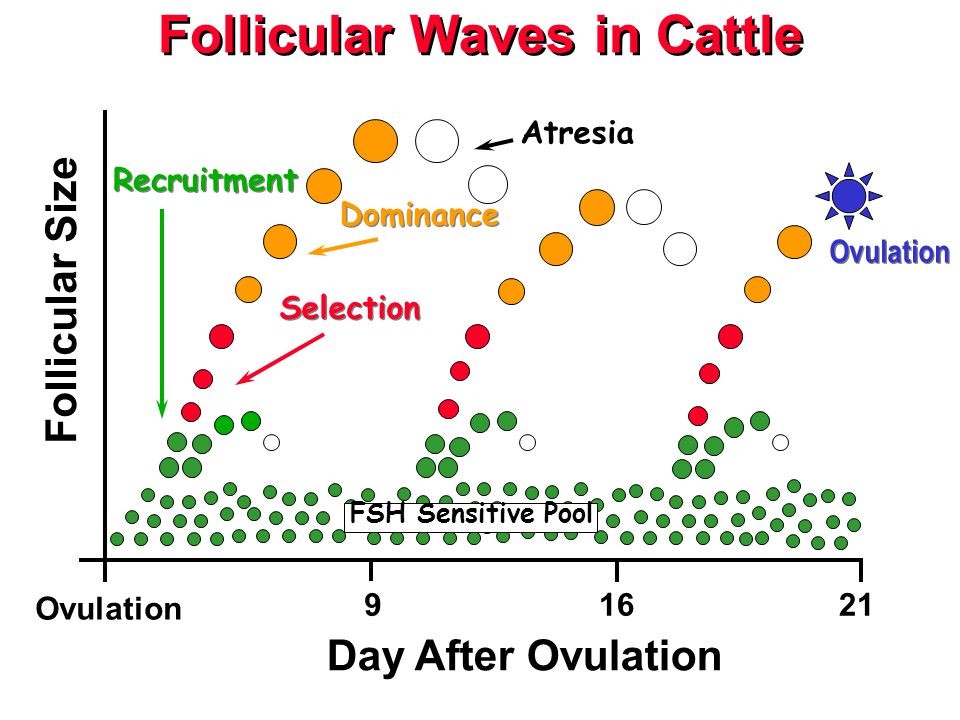
Regulation of estrous cycle length
Maternal recognition of pregnancy occurs around day 15 of the estrous cycle, when the embryo sends a signal to the mother that it is present and developing in the uterus. When a cow does not become pregnant, no signal is received from a developing embryo, and the estrous cycle must be repeated to allow for another opportunity to become pregnant. When maternal recognition of pregnancy does not occur, the uterus releases prostaglandin F2α (PG) to induce luteolysis (luteolysis means destroying the CL). If luteolysis does not occur, the cow will not be able to return to standing estrus and therefore will not have another opportunity to become pregnant during the breeding season.
Regulation of ovulation
As follicles grow they produce increasing amounts of estradiol. During the estrous cycle, when progesterone is present, circulating concentrations of estradiol increase and decrease as follicular waves grow and regress. When progesterone is not present, high concentrations of estradiol cause standing estrus and the behavioral changes associated with standing estrus. High concentrations of estradiol, in the absence of progesterone, stimulate the release of a surge of Gonadotropin Releasing Hormone (GnRH). This surge of GnRH results in a surge of LH, causing ovulation of the ovulatory follicle.
Hormones that regulates bovine estrus cycle
| Name of Hormones | Roles in Estrus Cycle |
| Follicle Stimulating Hormone (FSH) | Recruitment of the group of small follicles from the pool of growing follicles on each ovary. |
| Luteinizing Hormone (LH) | 1. Stimulation of the continued growth of follicles following selection.
2. A preovulatory surge of LH results in the ovulation of the ovulatory follicle |
| Progesterone (P4) | Inhibits ovulation and prevents females from coming into estrus. |
| Estradiol (E2) | Elevated concentrations in the absence of progesterone cause behavioral changes associated with standing estrus and cause the release of a surge of GnRH. |
| Gonadotropin Releasing Hormone (GnRH) | Causes the preovulatory surge of LH to occur, resulting in ovulation of an ovulatory follicle. |
| Prostaglandin (PF2α) | PG Induces the destruction of the CL |
Phases of the Estrous Cycle
The estrous cycle has two major phases:
- Follicular Phase: Also known as proliferative or estrogenic phase. Oocyte maturation ,ovulation occurs, estradiol form the follicle is dominant. These phase include proestrus and estrus phase.
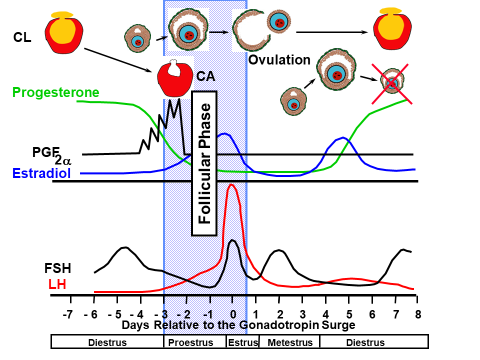
- Luteal Phase: This phase is known as secretory phase – corpus lueteum forms, fertilization and embryo development , progesterone from the CL is dominant. This phase include estrus and diestrus
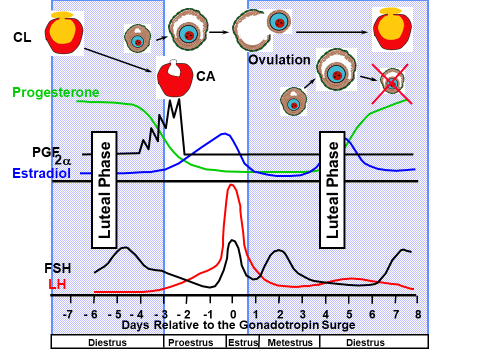
The stages of estrus cycle
Similarly to other domestic animals the estrus cycle in the cow can be divided into four phases:
- Proestrus
- Estrus
- Metestrus
- Diestrus

PROESTRUS
Regression of the corpus luteum of the previous cycle and drop in the progesterone concentrations in circulation. The dominant follicle is selected and grows producing increasing amounts of oestradiol. In late proestrus, the influence of oestrogens on the reproductive tract and behavior of the cow can be observed.
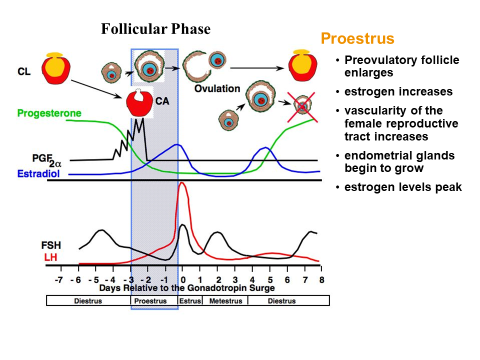
ESTRUS
It is the period of sexual receptivity during which mating and ovulation occurs in most species and the corpus luteum begins to form. There is increasing level of estrogen produced by the synergistic effects of the theca and granulose cells. The graffian follicle is large and mature and ovum undergoes certain maturation changes. Increased level of estrogen stimulates hypothalamic LHRH release by positive feedback mechanism, thus the ovulatory LH surge before ovulation. The oviduct is tonic, the epithelium mature and cilia are active, concentration of the oviduct is occurring a close affinity to the graffian follicle. Increase amount of oviduct fluid is being secreted.
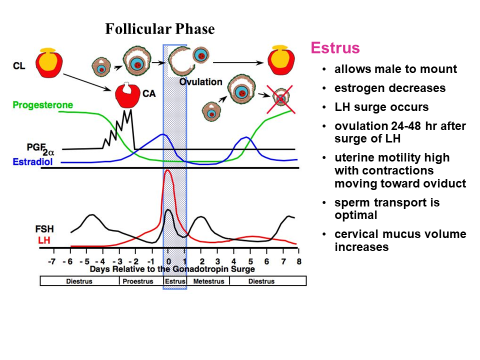
Signs of Estrus
| Animal | Signs |
| Cow | Bellowing, mounting, cervical mucus discharge, frequent urination, swollen vulva, reduced milk yield and reduced feed intake |
| Buffalo | Frequent urination, teat swelling, reduction in milk yield, bellowing – many buffaloes come to heat durin night and his makes heat detection difficult in these animals |
METESTRUS
It is the transitional period between ovulation and fully development of the corpus luteum. During this period, the reproductive system switches from estrogen to progesterone dominance. It is post ovulatory phase during which the granulosa and thecal cell lining the ruptured follicles begins to grow and reorganize in to a structure called the carpus luteum (CL), corpus luteum hemorrhagicum, which is the principal site of progesterone production.
In the cow, during the early part of the metestrus, the epithelium over the caruncles of the uterus is very hyperemic and some capillary hemorrahge occurs, this is called post estrual or metestrus bleeding. This is due to the estrogen withdrawal. The mucus secretion decreases and the glands of the endometrium grow rapidly. The uterus becomes soft and pliable, due to the relaxation of the uterine muscles.
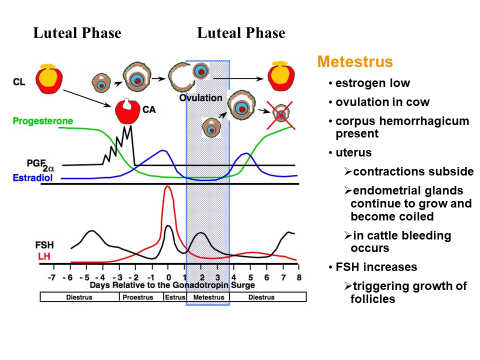
DIESTRUS
It is the longest period of the estrus cycle in the domestic animal, including cow, sheep, Goat, sow and mare. It is amid luteal period, it is relatively long period of sexual quiescence (rest) between two successive estrus cycles in polyestrous animals. In this period, the CL is fully developed, actively functional and the reproductive organs are under the dominant influence of progesterone for the preparation of the uterus for implantation of zygote and its growth as fetus.
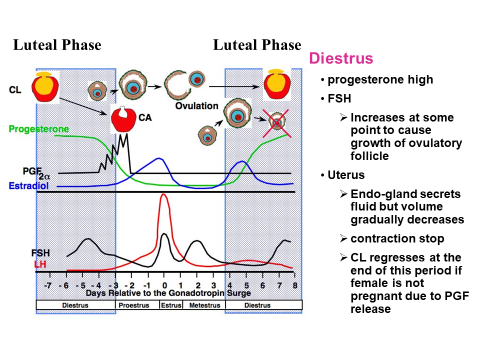
LH is required for maintaining the CL in domestic animals. In rodents PRL is luteotropic. The endometrium is becomes thicker and glands hypertrophy. The cervis is constricted and the vaginal mucus is scanty and sticky. The mucus membrane of the vagina is pale. The uterine muscle is relaxed. In the non gravid uterus PGF2 is produced and it passes in to the uterine vein, transferred to the ovarian artery and reach the CL by counter current exchange at the vein and artery. In CL the PGF interferes with the LH action. And produces vasoconstriction and arrests blood supply producing luteolytic agent. In the cow, mare, sow, ewe, doe, PGF2α is the natural luteolytic agent. in the cat, dog and primates PGF2α is not luteolytic and CL is maintained for 35-70 days ( pseudo pregnancy)
Conclusion
The bovine estrous cycle is regulated by hormones of hypothalamus –pituitary gonadal aix. The growth and development of follicles and the corpus luteum are regulated by changes in the secretion and patterns of different hormones. The ability to understand the estrous cycle will give you a better understanding of reproductive management and the control of the estrous cycle. The ability to control the estrous cycle also can increase the percentage of cows that conceive at the beginning of a breeding season.


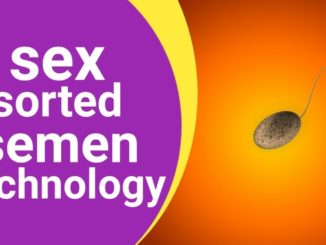

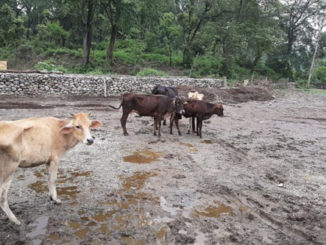

Be the first to comment